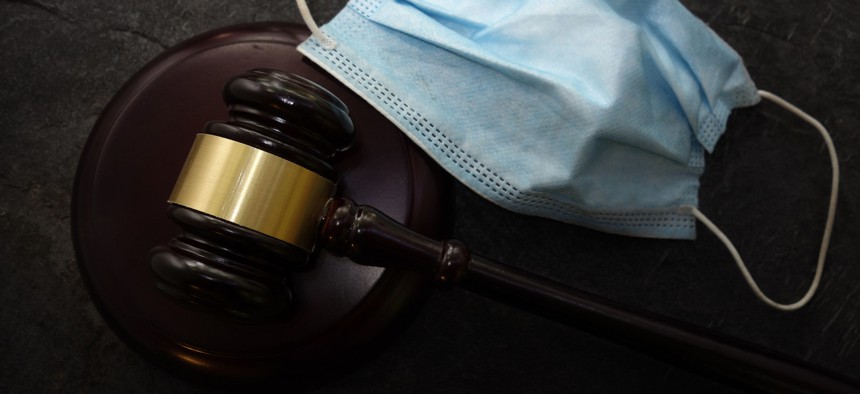
A 2020 lawsuit filed by federal correction officers in Connecticut argued they were entitled to hazard pay because they worked in close proximity to people, objects and surfaces infected with COVID-19 and were not provided sufficient personal protective equipment. zimmytws/Getty Images
Federal Prison Employees Ask the Supreme Court to Review COVID Hazard Pay Case
Attorneys for nearly 200 U.S. Bureau of Prisons workers in Connecticut said a federal appellate court effectively made it impossible for any federal worker to qualify for hazard pay related to “virulent biologicals” with its interpretation of federal regulations.
A group of nearly 200 U.S. Bureau of Prisons employees last week appealed a February decision by a federal appellate court denying them access to hazard pay in connection with their work during the COVID-19 pandemic, calling the ruling “overly narrow” and essentially deleting portions of federal regulations governing the pay category.
In a 10-2 decision by the U.S. Court of Appeals for the Federal Circuit earlier this year, the court said that under the Office of Personnel Management’s existing regulations governing hazard pay, only federal workers enlisted to work in a laboratory setting with ‘virulent biologicals’ are entitled to enhanced pay for dangerous work not included in their job description.
The ruling stemmed from a 2020 lawsuit filed by federal correction officers in Connecticut, who argued they were entitled to hazard pay because they worked in close proximity to people, objects and surfaces infected with COVID-19 and were not provided sufficient personal protective equipment.
Molly Elkin, an attorney representing the prison employees, said Monday that she believes the appeals court “just got it completely wrong.” On May 12, Elkin filed a petition asking the Supreme Court to take up the case.
“The 188 workers in this case, and the 10,000 to 12,000 correctional officers across the country had to go to work every day in this petri dish—they worked essentially inside the petri dish; their job is to work with in close proximity to inmates, that’s why they’re there,” she said. “And the regulations say that if you work with or in close proximity with virulent biologicals, you’re eligible for hazard pay. We meet all the regulatory and statutory definitions, so the federal circuit’s reading makes no sense to us.”
By finding that only those who “work with” virulent biologicals are eligible for hazard pay, Elkin wrote in her petition that the court effectively “deleted” the portion of the regulations pertaining to those who work “in close proximity” those hazards.
“[Under the court’s decision], basically the only way people can get hazard pay working with biologicals is those who work with them in vials or petri dishes or test tubes,” she said in an interview. “But presumably, the people with the vials in lab settings—the scientists and doctors in the federal workforce—those hazards are already taken into account when their jobs were classified. So under this decision, literally nobody can get hazardous duty pay at all.”
Elkin said she feels “strongly” that the Supreme Court should take up the case, although some elements of the case could potentially hurt its chances. While the court often waits for a judicial controversy, such as conflicting decisions across multiple appeals courts, that’s not possible in this instance, because all cases related to federal employee compensation must be channeled through the U.S. Court of Federal Claims and then the federal circuit, making it impossible for other circuits to weigh in on the issue.
“This is the only shot we have, because there’ll never be a split in the circuit courts, because [that court is] where federal employee pay claims go,” she said. “[The] one thing the Bureau of Prisons got right is they kept great records that are available to you and me that talk about each prison, how many inmates and staff members were infected and their days of infection. They know from records who had it, and what guards were assigned to be in close proximity to those inmates. We can prove the case, provided we’re let out of the gate.”
NEXT STORY: Social Security Facts and Myths







